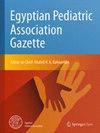Is hyperammonemia helpful in detecting syndromic tubulopathies with early extrarenal manifestations? A case report of Lowe’s syndrome
IF 0.5
Q4 PEDIATRICS
引用次数: 0
Abstract
Generally, it is not well known that Lowe’s syndrome may coexist with hyperammonemia and hipocarnitynemia. The importance of hyperammonemia in the diagnosis of kidney diseases is not completely understood. We present the history of a 13-year-old boy, admitted to the hospital due to proteinuria. In the past, the boy was diagnosed with binocular cataracts in infancy. Then he went through neurological diagnostic tests which diagnosed muscular hypotonia and psychomotor retardation but no inherited errors of metabolism were found. Proteinuria has been observed since the age of 2. Ultrasound imaging at the age of 5 showed the presence of a shading deposit in the kidney. At the age of 13, the boy was referred to the Pediatric Nephrology Ward. The laboratory tests revealed: a reduction of glomerular filtration rate, metabolic acidosis, proteinuria, hypercalciuria, increased activity of AST (SGOT), CK, LDH, hyperammonemia, and decreased concentration of total carnitine in blood serum. Based on the clinical presentation, Lowe’s syndrome was diagnosed. The genetic testing revealed an OCRL gene hemizygous mutation. Lowe’s syndrome is an example of a disease in which clinical symptoms—although occurring early and in high intensity—may not raise the suspicion of tubulopathy for a long time if they are not analyzed in a complex manner. There is a necessity to educate healthcare practitioners from other fields about the extrarenal symptoms of genetically determined tubulopathies. l-carnitine deficiency may be a symptom of proximal tubulopathy, including Lowe’s syndrome. l-carnitine deficiency leads to disturbances in the efficiency of the urea cycle, which results in hyperammonemia. Hyperammonemia is not only a symptom of inborn errors of metabolism and liver failure, but it may also lead to the diagnosis of tubulopathy. Since carnitine supplementation could have the desired beneficial effect on the patient’s general condition, it is postulated to conduct further studies on larger groups of patients with Lowe’s syndrome.高氨血症有助于检测具有早期肾外表现的综合征肾小管病吗?洛氏综合征病例报告
一般来说,人们并不清楚洛氏综合征可能与高氨血症和髋钙血症并存。高氨血症在肾脏疾病诊断中的重要性尚不完全清楚。我们介绍了一名因蛋白尿而入院的 13 岁男孩的病史。过去,这名男孩在婴儿期被诊断患有双眼白内障。随后,他接受了神经系统诊断检查,诊断结果为肌肉张力低下和精神运动发育迟缓,但未发现遗传性代谢错误。5 岁时,超声波成像显示肾脏中有阴影沉积物。13 岁时,男孩被转到儿科肾病病房。实验室检查结果显示:肾小球滤过率降低、代谢性酸中毒、蛋白尿、高钙血症、谷草转氨酶(SGOT)、肌酸激酶(CK)、低密度脂蛋白胆固醇(LDH)活性增高、高氨血症、血清总肉碱浓度降低。根据临床表现,诊断为洛氏综合征。基因检测显示,该患者的 OCRL 基因发生了半杂合子突变。洛氏综合征是临床症状出现较早且强度较高的一种疾病,如果不对这些症状进行复杂的分析,可能很长时间都不会引起对肾小管病变的怀疑。有必要让其他领域的医护人员了解由基因决定的肾小管病变的肾外症状。缺乏左旋肉碱可能是近端肾小管病变(包括洛氏综合征)的症状之一。高氨血症不仅是先天性代谢错误和肝功能衰竭的症状,还可能导致肾小管病变的诊断。由于肉碱补充剂可对患者的总体状况产生预期的有益影响,因此我们计划对更多的洛氏综合征患者进行进一步研究。
本文章由计算机程序翻译,如有差异,请以英文原文为准。
求助全文
约1分钟内获得全文
求助全文
来源期刊

Egyptian Pediatric Association Gazette
PEDIATRICS-
自引率
0.00%
发文量
32
审稿时长
9 weeks
期刊介绍:
The Gazette is the official journal of the Egyptian Pediatric Association. The main purpose of the Gazette is to provide a place for the publication of high-quality papers documenting recent advances and new developments in both pediatrics and pediatric surgery in clinical and experimental settings. An equally important purpose of the Gazette is to publish local and regional issues related to children and child care. The Gazette welcomes original papers, review articles, case reports and short communications as well as short technical reports. Papers submitted to the Gazette are peer-reviewed by a large review board. The Gazette also offers CME quizzes, credits for which can be claimed from either the EPA website or the EPA headquarters. Fields of interest: all aspects of pediatrics, pediatric surgery, child health and child care. The Gazette complies with the Uniform Requirements for Manuscripts submitted to biomedical journals as recommended by the International Committee of Medical Journal Editors (ICMJE).
 求助内容:
求助内容: 应助结果提醒方式:
应助结果提醒方式:


